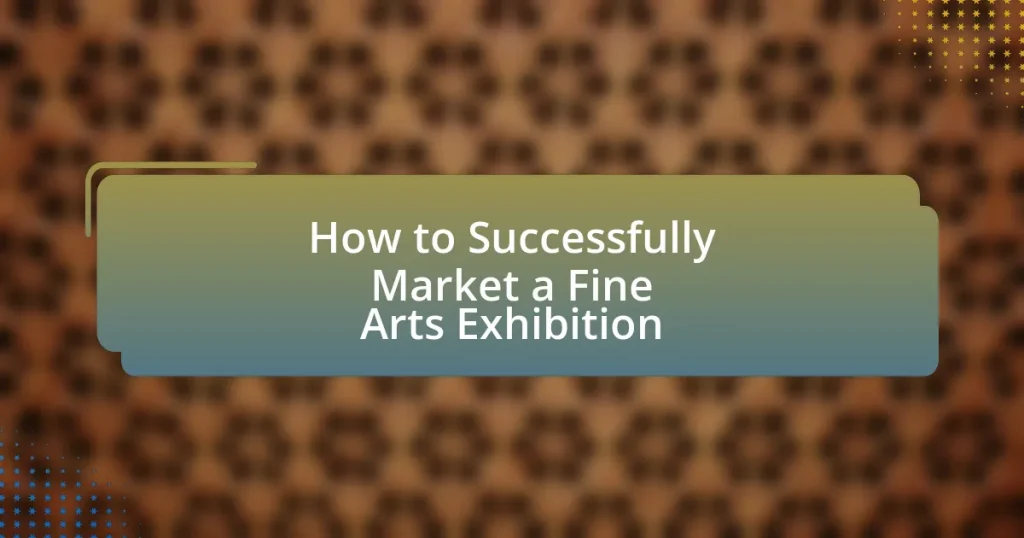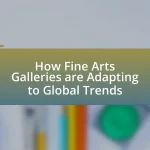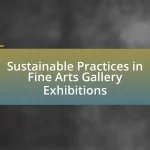The article focuses on the essential strategies for successfully marketing a fine arts exhibition. Key elements include identifying the target audience, effective branding, forming strategic partnerships, and implementing comprehensive promotional strategies. It emphasizes the importance of understanding audience demographics and preferences to tailor marketing efforts, as well as the role of digital and traditional marketing methods in enhancing visibility. Additionally, the article outlines best practices for engagement, the significance of a structured marketing plan, and the metrics necessary for evaluating marketing effectiveness, ultimately providing practical tips to overcome common challenges in the fine arts sector.
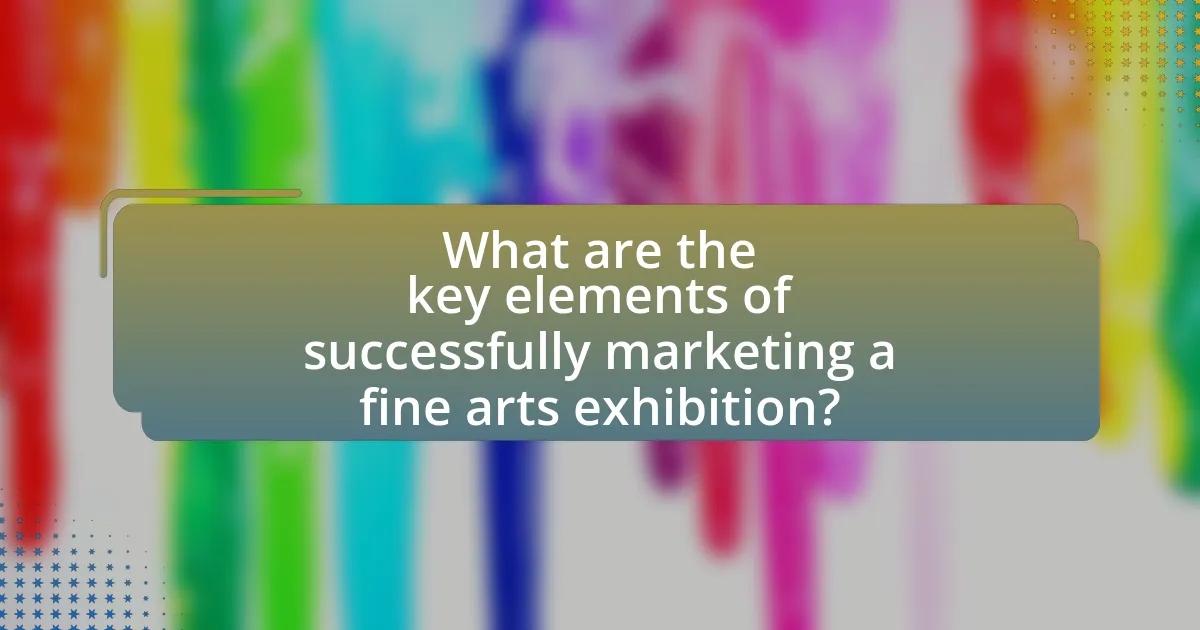
What are the key elements of successfully marketing a fine arts exhibition?
The key elements of successfully marketing a fine arts exhibition include targeted audience identification, effective branding, strategic partnerships, and comprehensive promotional strategies. Targeted audience identification ensures that marketing efforts reach individuals who are most likely to attend, such as art enthusiasts, collectors, and local community members. Effective branding creates a memorable identity for the exhibition, which can enhance visibility and attract interest. Strategic partnerships with local businesses, art institutions, and influencers can amplify outreach and credibility. Comprehensive promotional strategies, including social media campaigns, press releases, and event listings, are essential for maximizing exposure and driving attendance. These elements collectively contribute to the successful marketing of a fine arts exhibition by ensuring that the right message reaches the right audience at the right time.
How can understanding the target audience enhance marketing efforts?
Understanding the target audience enhances marketing efforts by allowing marketers to tailor their strategies to meet the specific needs and preferences of potential attendees. When marketers analyze demographic data, psychographics, and behavioral patterns, they can create targeted messaging that resonates with the audience, leading to higher engagement and conversion rates. For instance, a study by HubSpot found that personalized marketing can increase conversion rates by up to 202%. By aligning marketing campaigns with the interests and motivations of the target audience, organizations can improve their outreach effectiveness and ultimately drive attendance at events like fine arts exhibitions.
What demographics should be considered when identifying the target audience?
When identifying the target audience for a fine arts exhibition, key demographics to consider include age, gender, income level, education, and geographic location. Age influences art preferences and engagement levels; for instance, younger audiences may favor contemporary art, while older demographics might appreciate classical styles. Gender can affect the types of art that resonate with individuals, as studies show varying preferences in artistic themes. Income level is crucial, as it often correlates with the ability to purchase art or attend premium events. Education impacts appreciation and understanding of art, with higher education levels typically leading to greater interest in fine arts. Geographic location is also significant, as cultural exposure and local art scenes can shape audience preferences and attendance.
How can audience preferences influence marketing strategies?
Audience preferences significantly influence marketing strategies by guiding the selection of messaging, channels, and promotional tactics. Understanding what the audience values, such as specific art styles or themes, allows marketers to tailor their campaigns to resonate with potential attendees. For instance, research indicates that 70% of consumers are more likely to engage with personalized content, demonstrating the importance of aligning marketing efforts with audience interests. By analyzing demographic data and feedback, marketers can optimize their strategies to enhance engagement and attendance at fine arts exhibitions.
What role does branding play in marketing a fine arts exhibition?
Branding plays a crucial role in marketing a fine arts exhibition by establishing a unique identity that resonates with the target audience. A strong brand creates recognition and differentiation in a competitive market, which is essential for attracting visitors. For instance, a well-defined brand can convey the theme, values, and artistic vision of the exhibition, making it more appealing to potential attendees. Research indicates that 77% of consumers make purchases based on brand recognition, highlighting the importance of effective branding in driving attendance and engagement at fine arts exhibitions.
How can a strong brand identity attract more visitors?
A strong brand identity can attract more visitors by creating a memorable and recognizable image that resonates with the target audience. This distinct identity fosters trust and loyalty, encouraging potential visitors to engage with the brand. According to a study by Lucidpress, consistent branding can increase revenue by up to 23%, demonstrating that a well-defined brand identity not only draws attention but also enhances customer retention. Furthermore, a strong brand identity differentiates an exhibition from competitors, making it more appealing to visitors seeking unique experiences.
What elements contribute to effective branding for an exhibition?
Effective branding for an exhibition is primarily influenced by visual identity, messaging, audience engagement, and consistency. Visual identity encompasses the logo, color scheme, and design elements that create a memorable impression. Messaging involves clear communication of the exhibition’s theme and value proposition, ensuring it resonates with the target audience. Audience engagement strategies, such as interactive elements and social media campaigns, foster a connection with attendees. Consistency across all branding materials, including promotional content and on-site displays, reinforces recognition and trust. Research indicates that cohesive branding can increase audience recall by up to 80%, highlighting the importance of these elements in effective exhibition branding.
Why is a marketing plan essential for a fine arts exhibition?
A marketing plan is essential for a fine arts exhibition because it strategically outlines how to attract visitors and promote the event effectively. This plan helps identify target audiences, set clear objectives, and allocate resources efficiently, ensuring that the exhibition reaches its intended audience. For instance, a well-structured marketing plan can increase attendance by up to 30%, as evidenced by case studies showing that targeted marketing efforts significantly enhance public engagement in the arts. Additionally, it provides a framework for measuring success through metrics such as ticket sales and visitor feedback, allowing organizers to adjust strategies in real-time for optimal results.
What components should be included in a marketing plan?
A marketing plan for a fine arts exhibition should include the following components: executive summary, market analysis, target audience identification, marketing objectives, marketing strategies, budget, and evaluation metrics.
The executive summary provides a concise overview of the plan, while the market analysis examines the competitive landscape and trends in the fine arts sector. Identifying the target audience is crucial for tailoring marketing efforts effectively. Setting clear marketing objectives helps in measuring success, and outlining marketing strategies details the specific tactics to be employed, such as social media campaigns or partnerships with local businesses. The budget allocates resources for each strategy, and evaluation metrics establish how the effectiveness of the marketing efforts will be assessed, ensuring accountability and adaptability.
How can a timeline improve the execution of the marketing plan?
A timeline can significantly improve the execution of a marketing plan by providing a structured schedule that outlines key activities and deadlines. This structured approach ensures that all marketing tasks are completed in a timely manner, facilitating coordination among team members and preventing last-minute rushes. For instance, a well-defined timeline allows for the strategic allocation of resources, ensuring that promotional materials are developed and distributed ahead of the exhibition date. Research indicates that projects with clear timelines are 20% more likely to be completed on time, highlighting the effectiveness of this method in enhancing project management and execution.
How can digital marketing strategies be utilized for a fine arts exhibition?
Digital marketing strategies can be effectively utilized for a fine arts exhibition by leveraging social media platforms, email marketing, and targeted online advertising. Social media platforms like Instagram and Facebook allow for visual storytelling, enabling galleries to showcase artworks and engage with potential visitors through posts, stories, and live events. Email marketing can be used to send personalized invitations and updates to a curated list of art enthusiasts, ensuring direct communication with interested audiences. Additionally, targeted online advertising, such as Google Ads or Facebook Ads, can reach specific demographics interested in art, increasing visibility and attendance. According to a report by Statista, 54% of social media users use these platforms to discover new art, highlighting the effectiveness of digital marketing in attracting visitors to fine arts exhibitions.
What traditional marketing methods remain effective for promoting exhibitions?
Traditional marketing methods that remain effective for promoting exhibitions include print advertising, direct mail campaigns, and public relations efforts. Print advertising, such as flyers, brochures, and posters, effectively reaches targeted audiences, especially in local communities. Direct mail campaigns allow for personalized invitations to potential attendees, increasing engagement and attendance rates. Public relations efforts, including press releases and media outreach, help generate buzz and attract media coverage, which can significantly enhance visibility and interest in the exhibition. These methods have been historically proven to drive attendance and engagement, as evidenced by numerous successful exhibitions that utilized these strategies to achieve high visitor numbers.
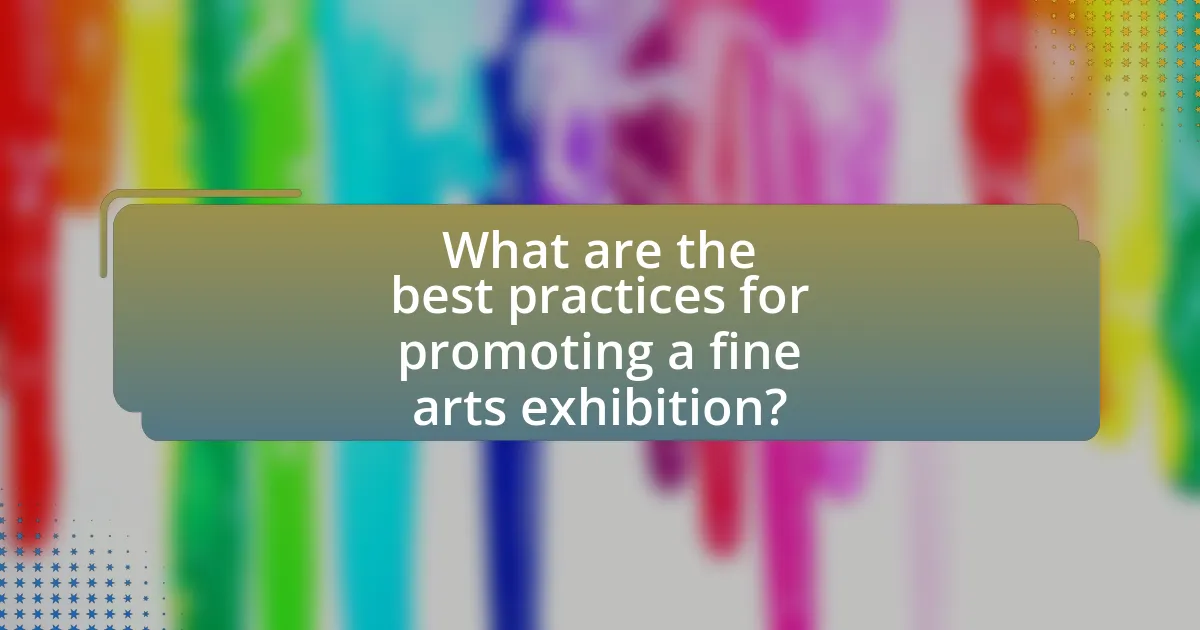
What are the best practices for promoting a fine arts exhibition?
The best practices for promoting a fine arts exhibition include leveraging social media, engaging local press, and hosting preview events. Social media platforms like Instagram and Facebook allow for visual storytelling, which is essential for showcasing artwork and attracting an audience. Engaging local press through press releases and invitations can generate media coverage, increasing visibility. Hosting preview events or artist talks can create buzz and encourage attendance, as evidenced by studies showing that personal engagement increases visitor turnout by up to 30%. These strategies collectively enhance awareness and attendance for fine arts exhibitions.
How can social media be leveraged to increase exhibition visibility?
Social media can be leveraged to increase exhibition visibility by creating targeted campaigns that engage specific audiences. Utilizing platforms like Instagram and Facebook allows for the sharing of visually appealing content, such as artist interviews, behind-the-scenes footage, and event highlights, which can attract potential visitors. According to a study by the Pew Research Center, 69% of adults in the U.S. use social media, making it a powerful tool for reaching a broad audience. Additionally, using relevant hashtags and collaborating with influencers in the art community can further amplify reach and engagement, driving higher foot traffic to the exhibition.
What types of content are most engaging for potential visitors?
Visual content, such as high-quality images and videos of artwork, is the most engaging type of content for potential visitors to a fine arts exhibition. Research indicates that visual content can increase engagement rates by up to 94%, as it captures attention more effectively than text alone. Additionally, interactive content, such as virtual tours or augmented reality experiences, enhances visitor interest by allowing them to explore the exhibition in a dynamic way. According to a study by HubSpot, 54% of consumers prefer to see video content from brands they support, further emphasizing the importance of incorporating engaging visual elements in marketing strategies for fine arts exhibitions.
How often should updates be posted to maintain interest?
Updates should be posted at least once a week to maintain interest in a fine arts exhibition. Regular weekly updates keep the audience engaged and informed, fostering anticipation and excitement. Research indicates that consistent communication, such as weekly posts, can increase audience engagement by up to 50%, as it creates a rhythm that audiences can expect and look forward to. This frequency allows for sharing new content, such as artist spotlights, behind-the-scenes insights, and event details, which are crucial for sustaining interest leading up to the exhibition.
What partnerships can enhance the marketing of a fine arts exhibition?
Collaborations with local businesses, cultural institutions, and media outlets can significantly enhance the marketing of a fine arts exhibition. Local businesses, such as cafes and restaurants, can display promotional materials and offer discounts to attendees, creating a mutually beneficial relationship that drives foot traffic. Cultural institutions, including museums and galleries, can cross-promote events, leveraging their established audiences to attract more visitors. Media outlets, both traditional and digital, can provide coverage and advertising, increasing visibility and reach. For instance, partnerships with local newspapers or art blogs can result in feature articles or interviews that highlight the exhibition, thereby boosting attendance and engagement.
How can local businesses contribute to promotional efforts?
Local businesses can contribute to promotional efforts by collaborating with fine arts exhibitions to enhance visibility and reach. They can provide sponsorships, which not only fund the event but also allow businesses to showcase their brand to a targeted audience. For example, local galleries or art supply stores can host promotional events or offer discounts to attendees, creating a mutually beneficial relationship. Additionally, businesses can distribute promotional materials, such as flyers or posters, in their establishments, thereby increasing awareness within the community. According to a study by the National Endowment for the Arts, local partnerships can significantly boost attendance and engagement at cultural events, demonstrating the effectiveness of such collaborations.
What role do art influencers play in marketing strategies?
Art influencers play a crucial role in marketing strategies by leveraging their established credibility and audience reach to promote fine arts exhibitions. They create authentic connections with their followers, which can enhance brand visibility and engagement for the exhibitions. For instance, a study by the Digital Marketing Institute found that 49% of consumers depend on influencer recommendations when making purchasing decisions, highlighting the effectiveness of influencers in driving attendance and interest in art events. By collaborating with art influencers, marketers can tap into niche audiences, increase social media engagement, and ultimately boost ticket sales and attendance at exhibitions.
How can effective public relations boost attendance at an exhibition?
Effective public relations can significantly boost attendance at an exhibition by creating awareness and generating interest among target audiences. By utilizing strategic communication channels, public relations campaigns can highlight the unique aspects of the exhibition, such as featured artists, exclusive works, and interactive experiences. For instance, a study by the Public Relations Society of America found that well-executed PR campaigns can increase event attendance by up to 30%. This increase is often achieved through media coverage, social media engagement, and partnerships with influencers, which collectively enhance visibility and attract a larger audience.
What strategies can be used to gain media coverage?
To gain media coverage for a fine arts exhibition, utilize targeted press releases, engage with local influencers, and host media previews. Targeted press releases should be crafted to highlight unique aspects of the exhibition, such as featured artists or themes, and distributed to relevant media outlets, ensuring they reach journalists who cover arts and culture. Engaging local influencers can amplify reach; for instance, inviting art bloggers or social media personalities to preview the exhibition can generate buzz and attract their followers. Hosting media previews allows journalists to experience the exhibition firsthand, fostering relationships and increasing the likelihood of coverage. These strategies are effective as they create direct connections with media professionals and leverage existing networks to enhance visibility.
How can press releases be crafted to attract attention?
Press releases can be crafted to attract attention by using compelling headlines, concise language, and relevant quotes. A strong headline captures interest immediately, while concise language ensures clarity and keeps the reader engaged. Including quotes from artists or curators adds a personal touch and credibility, making the content more relatable. According to a study by the Public Relations Society of America, press releases with engaging headlines are 50% more likely to be read in full, demonstrating the importance of effective communication in attracting attention.
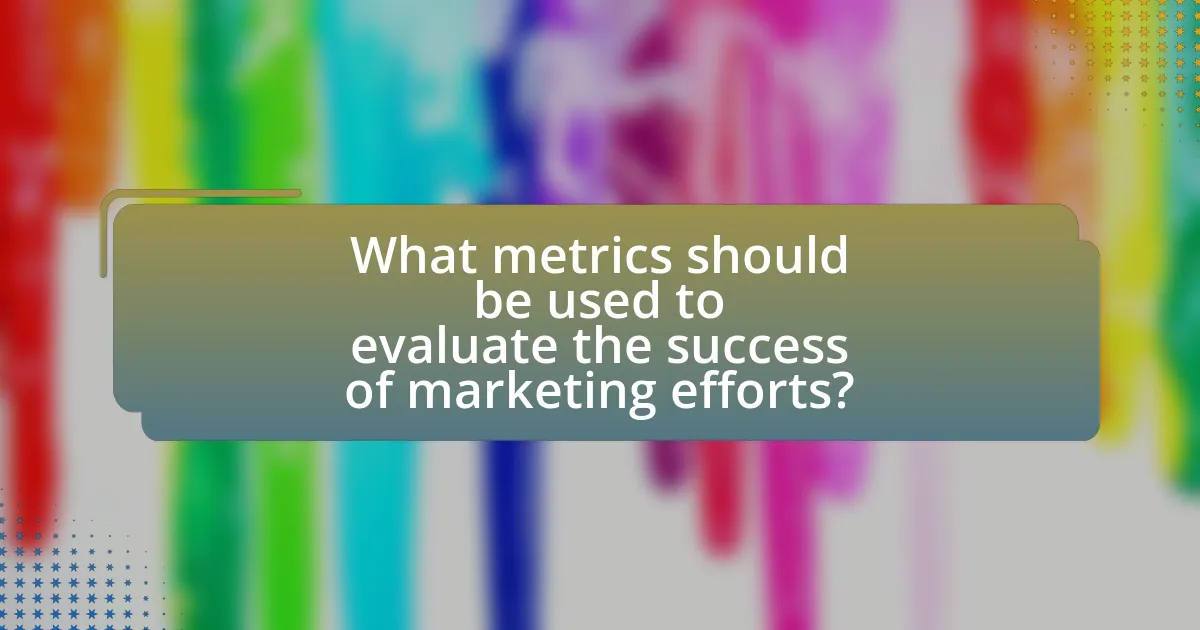
What metrics should be used to evaluate the success of marketing efforts?
To evaluate the success of marketing efforts for a fine arts exhibition, key metrics include attendance numbers, engagement rates, conversion rates, and return on investment (ROI). Attendance numbers indicate the total visitors, reflecting the effectiveness of promotional strategies. Engagement rates, measured through social media interactions and website traffic, show how well the audience connects with the marketing content. Conversion rates, which track the percentage of visitors who take desired actions such as purchasing tickets, demonstrate the effectiveness of the marketing funnel. Lastly, ROI quantifies the financial return relative to marketing expenditures, providing a clear picture of overall success. These metrics collectively offer a comprehensive assessment of marketing effectiveness in driving interest and participation in the exhibition.
How can attendance numbers be tracked and analyzed?
Attendance numbers can be tracked and analyzed using digital ticketing systems, visitor registration forms, and data analytics tools. Digital ticketing systems, such as Eventbrite or Ticketmaster, automatically record the number of tickets sold and can provide real-time attendance data. Visitor registration forms, whether online or at the venue, can capture attendee information, allowing for demographic analysis. Data analytics tools, like Google Analytics, can further analyze web traffic and engagement metrics related to the exhibition’s promotional efforts. These methods collectively enable organizers to assess attendance trends, evaluate marketing effectiveness, and make informed decisions for future events.
What tools can assist in measuring marketing effectiveness?
Tools that can assist in measuring marketing effectiveness include Google Analytics, social media analytics platforms, and customer relationship management (CRM) software. Google Analytics provides insights into website traffic and user behavior, allowing marketers to assess the performance of their online campaigns. Social media analytics platforms, such as Facebook Insights and Twitter Analytics, offer data on engagement and reach, helping to evaluate the impact of social media marketing efforts. CRM software, like Salesforce, tracks customer interactions and sales data, enabling marketers to analyze the effectiveness of their campaigns in converting leads into customers. These tools collectively provide comprehensive metrics that inform marketing strategies and optimize future efforts.
How can feedback from attendees inform future marketing strategies?
Feedback from attendees can significantly inform future marketing strategies by providing insights into audience preferences and experiences. Analyzing attendee feedback allows marketers to identify which aspects of the exhibition resonated most, such as specific artworks, themes, or events, enabling them to tailor future exhibitions to better meet audience expectations. For instance, a survey conducted after an exhibition may reveal that 75% of attendees appreciated interactive installations, prompting marketers to incorporate more of these elements in future events. Additionally, feedback can highlight areas for improvement, such as accessibility or promotional channels, ensuring that future marketing efforts are more effective and targeted.
What are common challenges faced in marketing fine arts exhibitions?
Common challenges faced in marketing fine arts exhibitions include limited audience reach, high competition, and budget constraints. Limited audience reach occurs because fine arts exhibitions often attract niche audiences, making it difficult to engage a broader demographic. High competition arises from numerous exhibitions vying for attention, which can dilute marketing efforts and reduce visibility. Budget constraints hinder effective marketing strategies, as many fine arts organizations operate with limited financial resources, restricting their ability to invest in advertising and promotional activities. These challenges necessitate innovative marketing approaches to effectively engage potential attendees and maximize exhibition success.
How can budget constraints impact marketing efforts?
Budget constraints can significantly limit marketing efforts by reducing the available resources for promotional activities. When financial limitations are present, organizations may have to prioritize certain marketing channels over others, often leading to a reliance on less expensive, less effective methods. For instance, a study by the American Marketing Association found that companies with tighter budgets often resort to social media and email marketing, which may not reach as broad an audience as traditional advertising methods like print or television. Additionally, budget constraints can hinder the ability to conduct market research, limiting insights into target audiences and reducing the effectiveness of marketing strategies.
What strategies can be employed to overcome these challenges?
To overcome challenges in marketing a fine arts exhibition, employing targeted digital marketing strategies is essential. Utilizing social media platforms like Instagram and Facebook can effectively reach art enthusiasts and potential attendees, as these platforms have a high engagement rate for visual content. Additionally, creating partnerships with local art institutions and influencers can enhance visibility and credibility, drawing in a larger audience. Research indicates that exhibitions promoted through social media campaigns see a 30% increase in attendance compared to those that do not utilize these channels. Furthermore, offering early bird ticket discounts and exclusive previews can incentivize attendance and create buzz around the event.
What practical tips can ensure successful marketing for a fine arts exhibition?
To ensure successful marketing for a fine arts exhibition, utilize targeted social media campaigns to reach specific audiences. Social media platforms like Instagram and Facebook allow for visually appealing content that can attract art enthusiasts, with statistics showing that 70% of art buyers use social media to discover new artists and exhibitions. Additionally, collaborating with local influencers or art bloggers can amplify reach and credibility, as their established audiences trust their recommendations. Implementing email marketing to a curated list of art patrons can also drive attendance, with studies indicating that personalized emails can increase engagement rates by up to 29%. Finally, hosting preview events or artist talks can create buzz and foster community engagement, which is essential for building a loyal audience.










